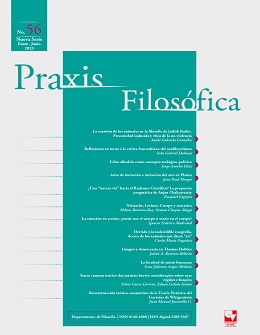A “Third Way” towards Scientific Realism? The Pragmatic Proposal of Anjan Chakravartty
Main Article Content
Anjan Chakravartty maintains that – traditionally - the scientific realism-antirealism debate has been eminently epistemic, the issue being whether or not we should commit to the belief that our best scientific theories are true or approximately true and that their core terms successfully refer to aspects of the world. However, contemporary versions of scientific realism show a clear trend towards deepening into the metaphysical aspects of science, to the point that one of the most prominent features of these are substantial metaphysical theses. Faced with this situation, Chakravartty affirms that, beyond certain “basic” metaphysical commitments – based on the scientific practice -, the scientific realist can maintain a more pragmatic – even skeptical – position in the face of the more “deep” metaphysical commitments, more typical of the metaphysics of science than of the debate that concerns us. This paper aims to demonstrate that the arguments put forward by Chakravartty fail to justify this pragmatic position, and offers an example in which this position is untenable for the scientific realist.
- Scientific Realism
- Pragmatic Realism
- Metaphysic of Science
- Metaphysic Commitments
- Scientific Antirealism
Ainsworth, P. (2011). Ontic Structural Realism and the Principle of the Identity of Indiscernibles. Erkenntnis, (75), 67–84. https://doi.org/10.1007/s10670-011-9279-x
Borge, B. (2013). ¿Qué es el realismo estructural óntico? Una aproximación al debate actual sobre el realismo científico. Revista Colombiana de Filosofía de la Ciencia, 13(27), 149-175. https://doi.org/10.18270/rcfc.v13i27.1636
Cartwright, N. (1983). How the Laws of Physics Lie. Oxford University Press. https://doi.org/10.1093/0198247044.001.0001
Chakravartty, A. (2007). A Metaphysics for Scientific Realism: Knowing the Unobservable. Cambridge University Press. https://doi.org/10.1017/CBO9780511487354
Chakravartty, A. (2017). Particles, causation, and the metaphysics of structure. Synthese, (194), 2273–2289 https://doi.org/10.1007/s11229-015-0913-z
Chakravartty, A. (2020). Acerca de la relación entre el realismo científico y la metafísica científica. En B. Borge, y N. Gentile (Eds.), La ciencia y el mundo inobservable. Discusiones contemporáneas en torno al realismo científico (pp. 97-120). Eudeba.
Cíntora, A. (2017). El disenso axiológico entre realistas y antirrealistas científicos. Praxis Filosófica, (45S), 11-23. https://doi.org/10.25100/pfilosofica.v0i45S.6063
Devitt, M. (1984). Realism and Truth. Princeton University Press.
Devitt, M. (2009). Putting Metaphysics First: Essays on Metaphysics and Epistemology. Oxford University Press. https://doi.org/10.1093/acprof:oso/9780199280803.001.0001
French, S. & Ladyman, J. (2003). Remodeling Structural Realism: Quantum Physics and the Metaphysics of Structure. Synthese, (136), 31-56. https://doi.org/10.1023/A:1024156116636
French, S. (2014). The Structure of the World: Metaphysics and Representation. Oxford University Press. https://doi.org/10.1093/acprof:oso/9780199684847.001.0001
French, S. (2019). Identity and Individuality in Quantum Theory. Stanford Encyclopedia of Philosophy.
Hacking, I. (1983). Representing and Intervening: Introductory Topics in the Philosophy of Natural Science. Cambridge University Press. https://doi.org/10.1017/CBO9780511814563
Kitcher, P. (1993). The Advancement of Science: Science Without Legend, Objectivity Without Illusions. Oxford University Press.
Kripke, S. (1972). Naming and Necessity. En D. Davidson, y G. Harman (Eds.), Semantics of Natural Language (pp. 253-355). D. Reidel Publishing Company. https://doi.org/10.1007/978-94-010-2557-7_9
Ladyman, J. (1998). What is Structural Realism? Studies in History and Philosophy of Science, 29(3), 409-424. https://doi.org/10.1016/S0039-3681(98)80129-5
Ladyman, J. (2014). Structural realism. Stanford Encyclopedia of Philosophy.
Laudan, L. (1984). Discussion: Realism without the real. Philosophy of Science, 51(1), 156-162. https://doi.org/10.1086/289171
Laudan, L. (1981). A Confutation of Convergent Realism. Philosophy of Science, 48(1), 19-49. https://doi.org/10.1086/288975
Newman, M. (1928). Mr. Russell’s “causal theory of perception”. Mind, XXXVII(146), 137-148. https://doi.org/10.1093/mind/XXXVII.146.137
Psillos, S. (1999). Scientific Realism: How Science Tracks Truth. Routledge.
Putnam, H. (1973). Explanation and Reference. En G. Pearce, y P. Maynard (Eds.), Conceptual Change (pp. 199-221). D. Reidel Publishing Company. https://doi.org/10.1007/978-94-010-2548-5_11
Putnam, H. (1974). Philosophy of Language and Philosophy of Science. PSA: Proceedings of the Biennial Meeting of the Philosophy of Science Association, 1974, 603-610. https://doi.org/10.1086/psaprocbienmeetp.1974.495829
Putnam, H. (1975). Mathematics, Matter and Method. Cambridge University Press.
van Fraassen, B. C. (1980). The Scientific Image. Oxford University Press. https://doi.org/10.1093/0198244274.001.0001
Worrall, J. (1989). Structural Realism: The Best of Both Worlds? Dialectica, 43(1-2), 99-124. https://doi.org/10.1111/j.1746-8361.1989.tb00933.x
Downloads
Accepted 2023-03-06
Published 2023-04-20

This work is licensed under a Creative Commons Attribution-NonCommercial-NoDerivatives 4.0 International License.
De acuerdo con nuestra política (Licencia Creative Commons CC BY-NC-SA 4.0) los artículos presentados y sometidos al proceso editorial en la revista Praxis Filosófica no tienen costo alguno para sus autores ni retribuciones económicas para la revista. El artículo de carácter inédito, producto de investigación o de algún proyecto que se presente a Praxis Filosófica, no podrá estar sometido a otro proceso de publicación durante el proceso que se lleve en nuestra revista.





